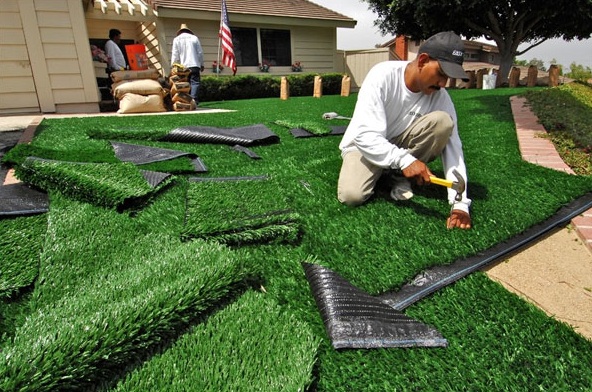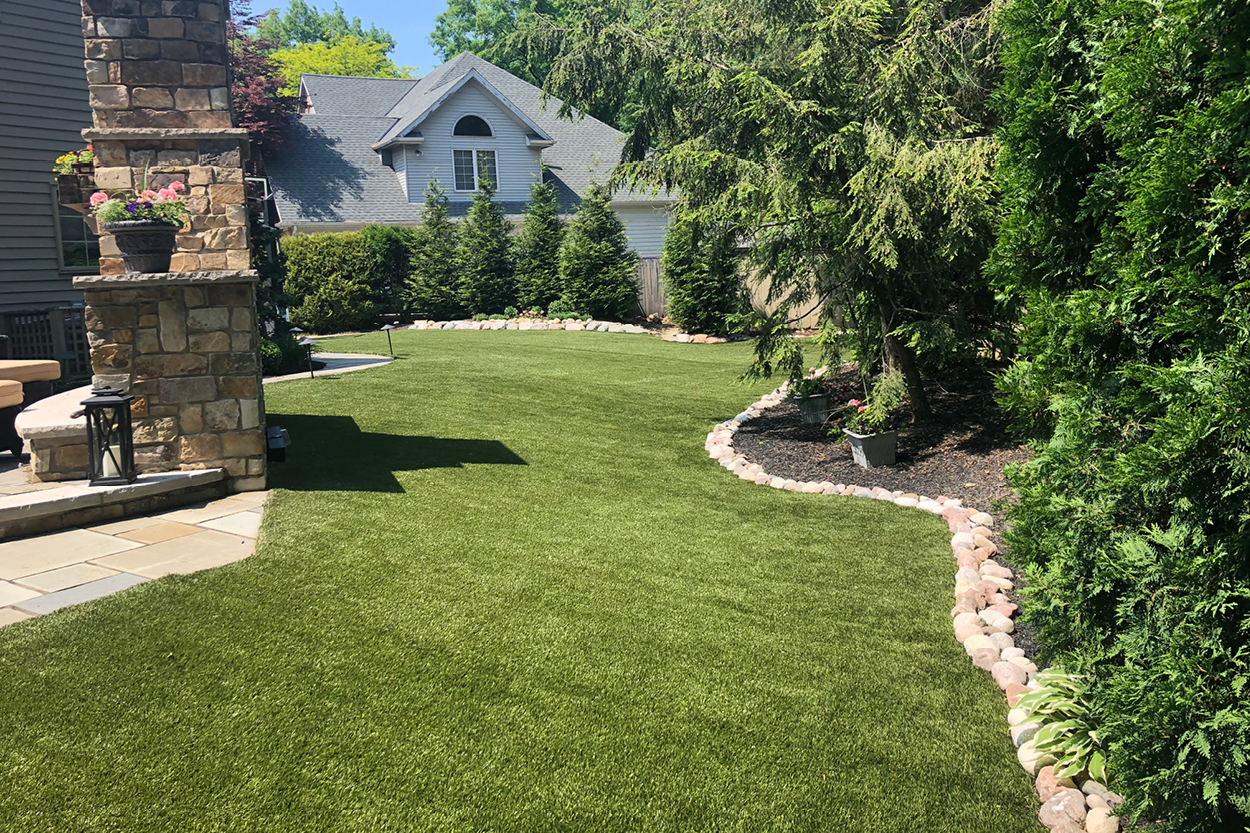Durable Arizona Artificial Turf for Home and Commercial Applications
Durable Arizona Artificial Turf for Home and Commercial Applications
Blog Article
Explore the Environmental Perks of Opting for Synthetic Grass Solutions
The adoption of artificial lawn options provides an engaging possibility to address pressing ecological difficulties. By significantly reducing water usage and lessening the application of unsafe chemicals, these choices not only advertise sustainable landscape design however likewise secure regional environments. Furthermore, the reduced carbon impact associated with decreased upkeep tasks adds to a more lasting strategy to land management. The implications of these benefits expand beyond simple preservation initiatives, increasing inquiries about their long-term impact on habitat conservation and general environmental balance. Checking out these dimensions reveals a complex interaction worth thinking about.
Water Preservation Benefits
Among the most considerable benefits of synthetic grass is its ability to save water. Standard grass lawns call for substantial irrigation, especially in areas vulnerable to drought or water restrictions. In comparison, synthetic grass does not need watering, dramatically lowering the overall demand for water sources. This function is specifically beneficial in deserts where water shortage is a pushing worry.
By removing the demand for regular watering, synthetic grass adds to sustainable landscape techniques and assists reduce the ecological impact of extreme water intake. The preservation of water extends to the decrease of runoff, which can lead to dirt disintegration and river pollution.
In addition, the installation of synthetic grass permits communities and property owners to allocate water sources extra effectively, concentrating on crucial uses such as drinking water and farming. The change towards fabricated lawn not only advertises accountable water use but likewise aligns with broader environmental objectives focused on preserving all-natural resources.
As communities progressively focus on sustainability, the water conservation advantages of synthetic grass provide an engaging case for its fostering in industrial and residential landscape design projects.
Decreased Chemical Usage
The change to artificial turf dramatically reduces the reliance on chemical treatments commonly used in natural grass maintenance. Traditional turf administration typically entails the application of plant foods, pesticides, and herbicides to advertise growth and control pests. These chemicals can pose dangers to human wellness, local wildlife, and the environment, adding to dirt and water contamination.
On the other hand, artificial turf gets rid of the demand for these dangerous materials. Once mounted, it needs minimal upkeep, largely containing routine cleaning and infrequent infill replenishment. This reduction in chemical usage not just benefits the immediate environment however also contributes to more comprehensive ecological stability. By reducing the launch of synthetic compounds into the environment, synthetic grass advertises healthier dirt and water systems.
Moreover, the absence of chemical runoff connected with artificial lawn installments helps protect regional waterways from pollution, sustaining marine life and preserving biodiversity. Turf installation phoenix az. As communities significantly focus on lasting methods, going with man-made turf presents a sensible solution that lines up with environmental preservation objectives. Through this change, homeowner can delight in lush eco-friendly spaces without endangering ecological wellness, leading the means for a much more sustainable future
Reduced Carbon Impact

Moreover, the installation of synthetic grass can result in substantial water conservation. Natural yards More about the author require substantial amounts of water for watering, which not only includes in the carbon impact linked with water extraction and treatment however likewise stress regional water resources. In contrast, man-made lawn requires very little upkeep, needing no watering, thereby significantly reducing water use and its connected energy prices.
Additionally, the longevity of synthetic grass adds to its lower carbon effect. With a life-span of as much as 15 years or more, the requirement for constant replacements is reduced, resulting in much less waste and lower power usage in manufacturing and throwing away conventional grass options. Generally, artificial turf presents a lasting alternative for ecologically conscious landscaping.
Habitat Conservation
Environment preservation is a critical factor to consider in the discussion over landscape design options, specifically when comparing man-made lawn to natural grass. All-natural yard lawns usually call for comprehensive upkeep, consisting of making use of herbicides, fertilizers, and pesticides, which can detrimentally influence local ecosystems. These chemicals can seep into the dirt and waterways, harming native flora and fauna and interrupting local habitats.
Fabricated grass removes the demand for damaging chemicals, therefore shielding neighboring wildlife and maintaining the integrity of bordering environments. The installment of synthetic grass can lead to the conversion of previous turf areas into more biodiverse landscapes, such as pollinator yards or native plant locations, which can support regional wildlife.
Inevitably, the transition to artificial grass not only preserves water and decreases upkeep initiatives but additionally cultivates an extra harmonious connection between human tasks and the natural environment, advertising environment preservation while doing so.
Long-Term Sustainability
Long-term sustainability is a vital consider evaluating the advantages of synthetic grass over conventional turf lawns. Among one of the most considerable benefits of synthetic grass is its durability; it can last up to 15-20 years with minimal upkeep, whereas natural lawn calls for constant reseeding and substitute. This long life decreases the demand for constant sources, such as water, fertilizers, and pesticides, which are important for maintaining a healthy and balanced turf yard.
In addition, artificial turf contributes to a decrease in carbon exhausts connected with lawn treatment equipment. Standard grass usually require gas-powered lawn mowers, leaners, and blowers, all of which contribute to air pollution. Arizona artificial turf. In contrast, man-made lawn eliminates the need for such tools, promoting a cleaner setting
Furthermore, the manufacturing of synthetic grass significantly uses recycled materials, improving its sustainability account. As suppliers embrace environmentally friendly practices, the ecological footprint of synthetic grass remains to decrease.

Conclusion
The fostering of man-made lawn services offers substantial environmental benefits, consisting of considerable water preservation, lowered reliance on damaging chemicals, and a lower carbon impact. Moreover, fabricated grass aids in preserving all-natural habitats by decreasing land disturbance and advertising long-term sustainability with making use of long lasting materials. Collectively, these variables underscore the possibility of synthetic grass to add positively to environmental health and wellness and supply a viable alternative to typical landscaping techniques in an increasingly resource-conscious world.
In contrast, man-made grass try this does not need watering, significantly decreasing the overall need for water resources. By lessening the launch of synthetic compounds Arizona turf right into the community, artificial grass advertises healthier soil and water systems.
Furthermore, the setup of artificial grass can result in significant water conservation. In contrast, man-made lawn needs minimal upkeep, needing no watering, thus significantly decreasing water use and its connected energy prices.

Report this page